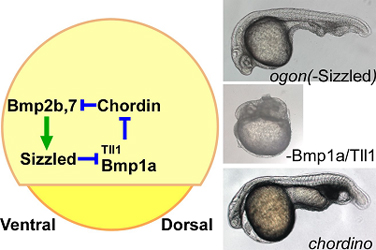| Got your back: Sizzled protects Chordin in dorsal-ventral patterning |
 |
 |

March 15, 2006 – During early development, the back of the embryo contends with the belly for territory. In this competition, the dorsal region defends itself by secreting antagonists to bone morphogenetic proteins, or Bmps, which act as ventralizing factors. The gradient that results as ventral Bmp signaling weakens in the face of cancellation by repressors from the dorsal region plays a central role in establishing the dorsal-ventral axis. One such BMP antagonist, Chordin, is itself subject to a form of counterattack, as it can be cleaved by Bmp1/Tolloid metalloproteinases, rendering it much less effective in neutralizing Bmp.
In studies of the zebrafish, many of the ventral-side players in this claim-staking have been identified, but to date only a pair of genes whose loss of function results in ventralization is known: the gene encoding Chordin, and a second, which codes for a zebrafish ortholog of Secreted Frizzled (Sizzled). Sizzled has been shown to dorsalize the embryo in a Chordin-dependent manner, and is noted for a mutant loss-of-function phenotype, named ogon, in which the ventral region expands without a corresponding decrease in neuroectoderm, but the mechanism by which it achieves its function remained unknown.
 |
| Schematic representation of the mechanism by which Sizzled inhibits Bmp signals. The phenotypes of embryos lacking Sizzled, Bmp1a/Tolloid-like1, or Chordin are shown on the right side |
Now, in a study led by Osamu Muraoka of the Laboratory for Vertebrate Axis Formation (Masahiko Hibi; Team Leader), that question has been resolved, with the finding that Sizzled protects Chordin from cleavage by Bmp1a and Tolloid-like1 (Tll1). The team reports in a March 5th advance online publication of Nature Cell Biology that Sizzled acts as kind of bodyguard to Chordin, enabling it to antagonize the ventralizing effects of other Bmps. “We knew that dorsal and ventral forces were counteracting each other to set up this axis,” says Hibi, “but it’s fascinating to see just how complex and highly evolved the negative regulation that underlies this seemingly simple system actually is.”
After confirming that Sizzled works in a Chordin-specific manner, as had been indicated by previous studies, Muraoka et al. looked at the means by which it does this. Knowing that Sizzled by itself has no dorsalizing effect in the absence of Chordin, they speculated that it might work by modulating the cleavage of Chordin by Bmp1/Tolloid family factors, and tested this idea by injecting Chordin mRNAs into wild type and Chordino mutant embryos, in the absence or presence of sizzled expression. They found that higher levels of intact Chordin and lower levels of the cleaved protein in embryos co-expressing sizzled, suggesting that its product somehow stabilizes Chordin against cleavage by metalloproteinases.
Muraoka next examined whether Sizzled interacts directly with either Tolloid-like1 or Bmp1a, both of which cleave Chordin in vitro and found that it bound both, with a higher affinity for Bmp1a. This finding jibed well with experiments that showed that Sizzled’s inhibitory effect was stronger against Bmp1a. Tests using truncated and chimerized versions of the Sizzled protein revealed that the critical domain is a cysteine-rich stretch that includes the same amino acid as is mutated in the ogon phenotype.
The picture of regulatory crosstalk that emerges is unexpectedly complex. Ventrally expressed sizzled keeps Bmp1a and Tolloid-like1 in check, freeing Chordin to antagonize other Bmps and dorsalize its side of the embryo, while at the same time generating the moderate Bmp activity needed for the development of ventral and lateral tissues. Here again, as in so many developmental processes, a mechanism that appears positively deterministic in fact involves an intricate system of negative feedback, with inhibitors inhibiting inhibitors until boundaries arise to keep mutual antagonists each in their own domains.
|


